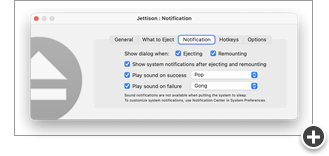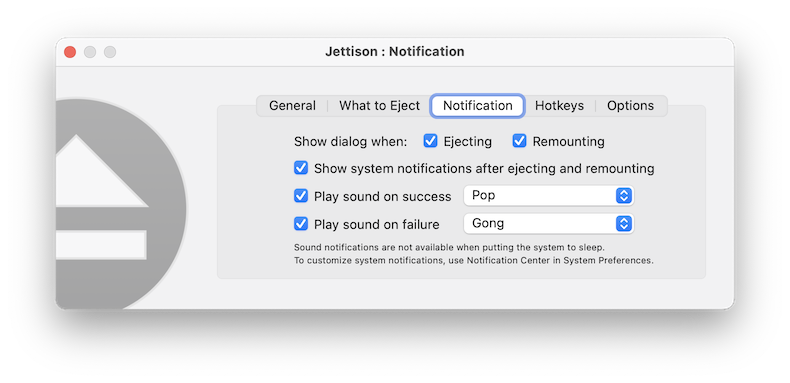You have the experience, you’ve got the talent - Jettison wants to hear from you! Jettison regularly recruits qualified candidates to staff both internal and external client projects. Qualified applicants are encouraged to submit a cover letter and current resume to careers@jettison.com. If You’re Over 50, Chances Are the Decision to Leave a Job Won’t be Yours. A new data analysis by ProPublica and the Urban Institute shows more than half of older U.S. Workers are pushed out. How can I stop Jettison from remounting drives when my Mac wakes up? Select 'Preferences' from Jettison's menu in the menubar. Click on the 'Extras' tab.
- Jettison Mac Not Working Windows 10
- Jettison Mac Not Working How To
- Jettison Mac Not Working Windows 7
- Jettison Mac Not Working Windows 10
This page covers the most common ways to resolve a non-functioning laptop touchpad. If you cannot resolve the issue for your laptop's touchpad after trying the solutions on this page, the touchpad is probably not working due to a less common cause. In this case, we recommend taking the laptop to a computer repair shop for further analysis.

Operating system not responding
The first thing to check is whether the computer and the operating system is not responding as well. It could be that the computer is frozen, meaning it is not responding to any commands you give it. In this case, the touchpad would also not be working.
To check for this issue, try pressing the Windows key to see if the Start Menu opens.
Fn key combination
Some laptops have an Fn key + function key combo to enable and disable the touchpad. If your laptop has this feature, press the button or keys to turn the touchpad on and off a few times.
External device
Some USB input devices automatically disable the touchpad when connected. As a troubleshooting step, turn off the computer, disconnect all external devices, then start the computer again to ensure one of them has not turned off the touchpad. If this fixes your problem, you can reconnect the USB device to continue troubleshooting or changing settings discussed in the next sections.
Check touchpad settings
NoteWe recommend you connect a USB external mouse or use the laptop's TrackPoint (if available) to perform the steps below. If you cannot get an external mouse to function, see: How to navigate Windows using a keyboard.

Look at your mouse/touchpad settings, as they may keep your touchpad from working or disable the touchpad entirely. To access the mouse settings, follow the steps below.
Windows users - Touchpad settings
- Press the Windows key, type touchpad, and select the Touchpad settings option in the search results.
- In the Touchpad window, make sure the Touchpad On/Off toggle switch is set to On. If it's Off, change it to be in the On position.
Windows users - Mouse settings
- Press the Windows key, type Control Panel, and then press Enter.
- Click the Hardware and Sound option.
- Under Devices and Printers, click the Mouse option.
If the Control Panel View by option is set to Small icons, click the Mouse option in step 2 above.
- In the Mouse Properties window that opens, locate your touchpad settings. They are usually under the far right tab next to Hardware (the name of the tab varies from manufacturer to manufacturer).
- Ensure there is a check in the box next to Enable touchpad.
- Adjust any other settings to your liking, then click Apply, then OK.
- Test your touchpad.
If you do not see a touchpad tab in the Mouse Properties window, try the following steps.
- In the Mouse Properties window, click the Hardware tab.
- Check for an entry in the Devices list named HID-compliant mouse. If you have a USB mouse connected to your laptop for troubleshooting purposes, you may see two HID-compliant mouse entries. Click on each entry to find the one that does not have USB in the Location property.
- When you find the HID-compliant mouse entry for the touchpad (the non-USB entry), click the Properties button.
- In the HID-compliant mouse Properties window, check the Device status to see if it states, 'This device is working properly.' If it states anything else, then there is a problem with the touchpad.
- If the touchpad device is not working properly, you can try updating the drivers. Click the Change settings button, click the Driver tab, then click the Update Driver button. Click the Search automatically option to allow Windows to look for an updated driver on the computer and on the Internet.
Jettison Mac Not Working Windows 10
If you do not see a non-USB HID-compliant mouse device on the Hardware tab, the touchpad may have been disabled in the BIOS (see the BIOS setup section below). If the touchpad is not disabled in BIOS, Windows may have issues (see the defective hardware section).
Apple macOS users
- For macOS, access the System Preferences in the Apple menu at the top of the desktop screen. For MacBook Pro, click the System Preferences icon at the bottom of the desktop screen.
- In the System Preferences window, click the Trackpad icon to open the Trackpad settings.
- Adjust any trackpad settings you prefer to change.
- Test the trackpad to see if it works.
Checking Device Manager and updating drivers
NoteWe recommend you connect a USB external mouse or use the laptop's TrackPoint (if available) to perform the steps below. If you cannot get an external mouse to function, see: How to navigate Windows using a keyboard.
If the touchpad still isn't working, the Windows Device Manager can tell you detailed information about hardware issues and help you update drivers. For example, if there's a yellow exclamation mark or red X next to it, there's a hardware or software issue. To locate the touchpad in Device Manager, follow the steps below.

- Press the Windows key and type device manager, then press Enter.
- Under Your PC, the touchpad is either going to be listed under Mice and other pointing devices, or under Human Interface Devices. If it's listed under Human Interface Devices, it likely is named as HID-compliant touchpad or similar. Double-click one of the two to locate the touchpad.
- Locate your touchpad and right-click the icon and select Update Driver Software.
If you see two entries named HID-compliant mouse, right-click on each and select Properties. In the Properties window, on the General tab, check the Location value. If the Location is 'on I2C HID Device,' that is the touchpad device on your laptop.
- Click Search automatically for updated driver software and follow the steps (if the drivers are out of date).
Right-clicking the touchpad icon gives you the option to either enable or disable it, depending on the device's status. If disabled, re-enable, and test the touchpad. If it's already enabled, change it to disabled, then re-enable it. Sometimes toggling this setting 'resets' and fixes the touchpad.
NoteIf you do not see the touchpad device listed in the Device Manager, it may be disabled in BIOS (see the BIOS setup section below). If the touchpad is not disabled in BIOS, Windows may have issues (see the defective hardware section).
Check BIOS setup
Make sure the touchpad is not disabled in the BIOS setup. Once in BIOS setup, check the hardware device settings and if the touchpad is disabled, re-enable it and restart the laptop.
Corrupt operating system files
Another possible cause for a malfunctioning touchpad is corrupt operating system files. While you would notice other issues as well due to corrupt system files, this could result in the touchpad not working.
Fixing this requires you to activate a restore point at a date before the touchpad stopped working, or you may need to perform an operating system repair installation. The repair installation requires you to access a restore partition on the hard drive or use an operating system install disc.
Jettison Mac Not Working How To
Defective hardware
Finally, if the touchpad still is not working correctly or at all after trying the troubleshooting steps above, it may be defective. Contact the computer manufacturer for further suggestions or take the laptop to a computer repair shop. It could require replacement of the touchpad itself or another hardware component. If the touchpad cannot be fixed, you could connect and use an external mouse as a workaround.
Additional information
- See our touchpad definition for further information and related links.
At least half of the American labor force is working from home, and the question now confronting bosses isn’t when their employees can come back to the office but whether they should do so at all. More than two months into the quarantine, coronavirus testing, contact tracing, and treatment protocols are still works in progress in the United States, and a vaccine is still some time away.
Not coincidentally, employers keep pushing back their projected return dates. When offices do return, they may limit themselves—because of state orders or their own concerns about preventing employees from getting sick—to just 25 or 30 percent occupancy. But the quiet part of this dilemma needs to be said out loud now: When should you go back to the office? You shouldn’t.

Many people in a variety of industries—manufacturing, retail, transportation, health care, and more—cannot work from home, of course. Yet the pandemic has shown just how many companies can function adequately, even successfully, without placing all their employees in the same office. If you run an organization whose employees are more or less getting their work done at home, listen to that little voice in your head. Return to the office now? That’s crazy talk. I’m only telling you what you already know.
More in this series
The Workforce Is About to Change Dramatically
Derek ThompsonTo Safely Reopen, Make the Workweek Shorter. Then Keep It Shorter.
Alex Soojung-Kim Pang
Going to the office has a few advantages: ergonomic furniture, mental separation between work and the rest of life, a daily motivation to dress like an adult and get out of the house. But the main point of going to the office is that all of your co-workers are there too.
Yet any return to work before a vaccine is available will have employees distanced, possibly masked. Many offices will operate with reduced occupancy. The places where people normally gather—conference rooms, the break room, the watercooler—may be off-limits. The corporate culture that so many employers prize is based on a level of interaction that will not be regained simply by being in the same building, let alone being in the same building with only a fraction of the workforce present. Until a coronavirus vaccine becomes available, corporate culture is over.
Sure, office planners can certainly envision a new workplace: new cubicle designs, touchless elevator buttons, ventilation-system upgrades to ensure fresh air, rigorous cleaning protocols, schedule shifting, and the closure of common spaces. Employers are looking to invest in their own testing systems—something the federal government has been unable or unwilling to set up—and may require temperature checks for all employees. It all sounds so grim, time-consuming, and expensive. If your morning routine wasn’t long enough already, you’ll love waiting in socially distanced lines to get your forehead scanned.
The other option for remote workers is: Just don’t go back.
Some employers—including Google and Facebook—have already extended work-from-home policies into late fall or early next year. That buys them time for governmental testing and tracing efforts to improve and for better treatments to become available. Twitter went a step further and is now allowing employees to work from home “forever.” That’s a long time. And lest anyone think liberal West Coast tech companies are the only ones making these moves, Fox News has extended its own work-from-home directive until June 15.
The Harvard public-health professor Joseph G. Allen—whose new book, Healthy Buildings, co-authored with the Harvard Business School professor John D. Macomber, may be one of the best timed in publishing history—has been advising companies on how they can return safely. Even if states allow businesses to be open, those businesses may be more cautious than their elected officials are. “Regardless of what governments say, right now we are still in a place where ‘work from home’ is the priority for workers that can. It’s the best hazard mitigation,” Allen told me. “That companies need to figure out how to bring people back safely is obvious. But that is different from the when.”
That when is not today, and the millions of Americans working from home should stay put.
Talk of returning to work seems like idle banter while children are still at home all the time. Why should employers invest in elaborate modifications to a workplace if, in six weeks, schools tell working parents that they have to stay home with their kids for many more months? Waiting seems prudent, especially considering that few major districts have announced their fall plans yet. Schools turn out to be a form of crucial infrastructure; as with water and electricity, if the education system is down, not much else can happen.
Corporate lawyers have a different set of concerns. Even as President Donald Trump demands that the nation reopen, his administration is failing to provide clear guidance on how to do so. Without such guidance, employers face unknown liability exposure, even when they are acting in good faith, if they expose employees to harm at or en route to work. This is why corporate America is desperately clamoring for protection against liability for coronavirus exposure. But they don’t have it yet.
The nation’s official health advisers also recommend that workers remain at home, if possible. The Centers for Disease Control and Prevention released watered-down guidance to employers late last week, after news reports suggested that the administration had blocked more detailed advice from the agency. Beyond telling employers to promote better hygiene and disinfect workspaces more often, it also urged them to encourage telework when feasible.
Insurers may well demand it. For the most part, employers are not well insured for a pandemic, and insurers are frequently denying coronavirus-related claims. Employers, in other words, will face financial pressure to better mitigate the risk. How? Well, one solution has been provided by the insurance industry itself. Nationwide announced recently that it would adopt a permanent hybrid work model, reducing its footprint to all but four facilities by the end of the year, for health and safety reasons.
Jettison Mac Not Working Windows 7

Employees do not mind. Trump has claimed that “real people” are clamoring to get back to work and resume their lives outside of home confinement. But polls suggest that those “real people” do not exist in significant numbers. Support for social-distancing measures remains strong. A Gallup poll last month showed that most people who are working from home want to keep doing so after the crisis abates. Meanwhile, employees whose jobs require them to leave home express trepidation about doing so; 60 percent feared exposing their families to COVID-19. Even higher percentages of African American and Hispanic workers voiced such concerns.
Jettison Mac Not Working Windows 10
The coronavirus has accelerated trends that were already under way. Companies were looking for ways to cut their spending on office space; many workers were eager to telecommute more often. Even assuming that remote work does put a dent in productivity or employee unity, bringing employees back is a high price to pay for corporate culture. The U.S. is fast approaching the 100,000-dead mark. We can’t go back to life before the pandemic. We have to get through it—and adapt. And, for the time being, that means more Zoom.